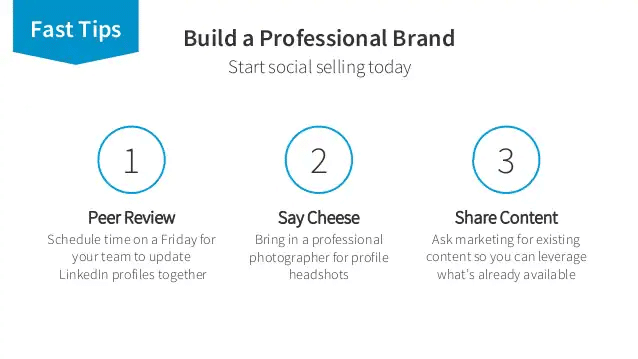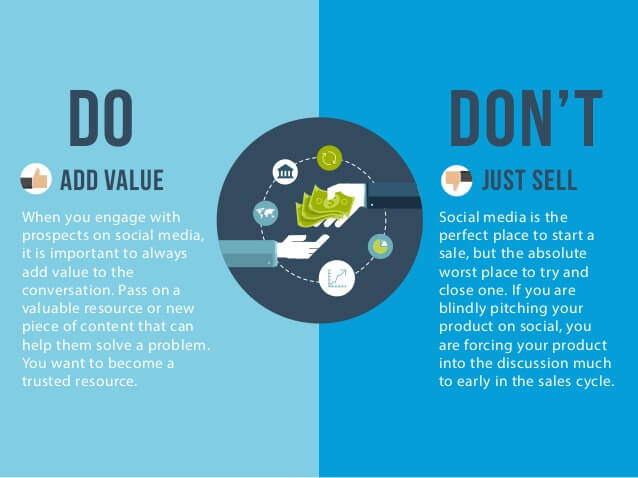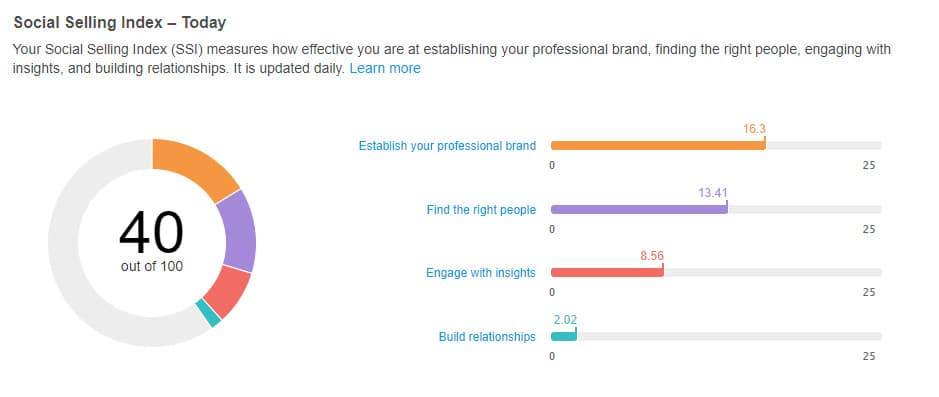If you are a B2B sales professional, you are probably familiar with the business networking site LinkedIn. You’re not? Then it might be time to add this channel to your sales strategy. LinkedIn is a social network for professionals, allowing you to connect, share, and learn from those in your network and within your industry.
LinkedIn has revolutionized networking and has even introduced a new selling strategy that has been more popular in the past couple of years. That strategy is called social selling and it is proving to be the go-to tactic of many successful sales professionals in multiple B2B industries.
But, before diving into how to implement this social selling into your general sales strategy, let’s cover the importance of how this can work to complement your current B2B selling techniques.
What Is Social Selling?
Social selling is a sales technique and practice where a sales representative uses their personal channels (preferably LinkedIn) to connect with prospects to start building a relationship. This allows for sales reps to not only engage with their new prospect but it provides a unique opportunity for them to practice social listening.
Social listening is an important tactic and can be described as monitoring your prospects' activity, posts, likes and interests which is mostly available on their social media channels. This will allow you to get an idea of what information in your pitch they might resonate with the most.
Along with listening, engaging (whether that be through liking or commenting), can allow you to build a relationship with your prospects and show that your interests are aligned. With social selling in B2B, relevant content is generated for your target audience. This will then make you recognizable as the expert and your prospect will automatically trust your product or service. This tactic is great for lead generations and like with other traditional B2B selling strategies, trust is at the center of building a relationship.
What Social Selling is Not
Social selling is not about overwhelming or flooding your prospects with endless messages or pitches. This can be considered spam and you might notice that instead of building a relationship with your prospect, you are quickly ruining it. Maybe you’ve even experienced it yourself and ignored spammy messages on LinkedIn!
Social selling is about more than just adding more and more contacts to your network. It’s about adding the right contacts to your network, the contacts that are most likely to connect with and buy your product, solution or service. Some contacts may “only” deliver valuable input that’s helpful for your personal growth, but even those will help you close deals in the end, because you refined your skills.
Interactions through the lens of social selling are meant to be meaningful and memorable so when your B2B prospect is ready to make a buying decision, your company or solution is top of mind.
Plus, when taking the time to meaningfully engage and interact with your prospect, you are more likely to build trust and loyalty.
Our best advice is to treat this tactic as a relationship-building exercise, not another cold calling channel!
Why is Social Selling on LinkedIn Important in B2B?
LinkedIn is known for its professional networking capabilities. Meaning, as a B2B sales professional LinkedIn is an easy way to identify companies and contacts that align with your business’s products and solutions.
Furthermore, the platform has become the go-to location for job seekers looking for new opportunities, business and industry-related news. Additionally, buyers do their research on products and solutions to solve their needs, and LinkedIn also has developed to a place where professionals actively go to learn. This social media platform is the perfect place for B2B sales professionals to implement social selling techniques because it’s almost expected, even welcomed by users.
But, if you are more interested in the statistics behind why B2B social selling on LinkedIn is important, here are some impressive figures:
- There are over 500 million active users on LinkedIn
- 40 percent of active users utilize LinkedIn daily
- 61 million users are senior-level influencers, while 40 million users are in decision-making positions
- More than 50 percent of all social media traffic to B2B websites and blogs comes from LinkedIn
- Generate brand visibility by sharing relevant and on-brand content to your audience –you are an extension of your company.
- Content coming from real people will resonate more with leads.
- Boost traffic to your website with the increased reach of your social selling efforts and turn that traffic into real leads.
Social Selling Pillars of Success
To be successful at B2B social selling, there are four main pillars – specifically identified by LinkedIn – to always keep in mind as your foundational strategy. Those pillars are:
Create a Professional Brand
In today’s world, B2B buyers can be very selective. They might only work with vendors, companies and services that they can trust. This proves to be challenging as sales representatives try to build new relationships with these buyers.
That’s why having a strong professional brand (Personal Brand) can show that you are an active participant in your industry and an expert for your specific field – meaning that you exactly understand their unique pain points and challenges.
Having built a personal brand on LinkedIn within your industry will lead to more direct inquiries from prospects. In addition, you might even notice that your response rate will begin to increase.

Source: www.slideshare.net
Focus on the Right Prospects
With B2B social selling on LinkedIn, you’ll notice that finding and connecting with prospects is more effective than traditional sales techniques like cold calling or cold emailing. Social media (specifically LinkedIn) makes identifying relevant prospects much easier. Some of those filterable criteria such as job role, function or industry are all available within the LinkedIn platform – or you can use a Sales Intelligence tool like Dealfront that will lead you directly to someone’s LinkedIn profile.
Engage With Insights
One of the best ways to start building a relationship with your prospects is to position yourself as a subject matter expert. To do this, consider sharing relevant industry content, comment on news alerts and build your professional brand. If you are comfortable, consider creating your own posts and articles with your specific point of view.
Ensure that you are staying up-to-date on industry news (especially news that would be relevant to your prospect).
Tip: Start to build relationships with those in your prospects’ network as well. Doing so, you can identify other decision-makers that are connected to your prospects or see if your target company has any key new hires.
Build Trusted Relationships
The best way to start building trust with your prospects is by sharing your perspective. Honesty is key! People can sense a dishonest offer, post or comment and will therefore appreciate if you’re honest about what you can solve and what you simply can’t. This can give you the opportunity to provide relevant information to them while also addressing their specific pain point. Another great way to build a relationship is to ensure that conversations are genuine. To do this, focus on the specific needs of the prospect first, and then selling second.
Understand the Algorithm
All these steps will benefit you as LinkedIn’s algorithm prioritizes content in the feed that is most relevant to the users interests or content that the user is likely to interact with. Building the relationship from the beginning and creating content with useful information will ensure that your posts are showing up on your prospects’ feeds. Write content that will likely receive comments as that metric is more important than reactions and will help you appear more frequently on the feed.
Furthermore, you should consider these 4 things:
- Posting regularly at times, users are most active (e.g. during usual work hours). Watch out when your target audience is most active and post accordingly.
- Write shoutouts and mentions – people will more likely react to a post, in which they or someone they know is mentioned with a name.
- Use relevant hashtags that your target audience might be looking for or which they are using themselves. But careful: Don’t use more that 5 hashtags per post!
- Try videos or pictures only! Sometimes it doesn’t take much to be relevant.
How to Start B2B Social Selling on LinkedIn
Getting started with B2B social selling on LinkedIn is simple when you follow these steps to ensure your profile is authentically you and up-to-date. It’s important to take the time to review your profile and optimize it so when you connect with prospects you appear as a subject matter expert and not as a spammy account.
1. Update Your LinkedIn Profile
As mentioned above, you should dedicate time to updating your LinkedIn profile. It might seem overwhelming as there is a lot of information you can provide but here are a few necessary elements of your profile that should be accurate and up-to-date.
Choose the Right Profile Picture
Your profile picture is the first thing your prospect will see when you send them a connection invitation via LinkedIn. This is basically your first impression and having the right picture can leave a lasting impact. Therefore, make sure that your picture is recent and looks like you. Additionally, wear what you would normally wear to an in-person meeting with a prospect in the photo. Finally, don’t forget to smile!
Make Your Headline More Than Just Your Job Title
The description at the top of your page is another great way to make an impactful and lasting first impression. Plus: there’s no rule that states it MUST be your job title. Some of the best profiles use the headline field to describe themselves, how they see their role, and why they do what they do. If you are struggling with a catchy headline, simply browse your LinkedIn feed for inspiration.
Examples for catchy headlines:
- Chief problem solver
- Passionate storyteller
- Job creator
- I turn words into revenue
- Helping companies grow
- etc
Turn Your Summary into Your Professional and Personal Story
Your summary on LinkedIn is basically your personal elevator pitch. It is arguably one of the most important parts of your profile. Your summary is your chance to tell your own story. Avoid simply listing your skills or the job titles you’ve had. Try to bring some character and life to why those skills matter to you and why you are passionate about what you do. Don’t forget to talk about how those skills make a difference to the people you work with.
Don’t be afraid to get personal and invest time into this section of your profile. It is worth the effort and is a great first step in building meaningful digital relationships with your prospects. Again: Browse your LinkedIn feed to gather inspiration!
List Your Relevant Experience and Skills
One of the quickest wins on LinkedIn is to identify your relevant professional experience and skills. By doing this, it allows you to add more context to your summary. Additionally, this can also help you build credibility with your prospects. Showing the companies you’ve worked for and the skills you possess can help your B2B prospects feel like they are in great hands when they choose to buy from you. The main takeaway here is to ensure that all of your experiences and skills are relevant to the needs of your prospects and the goals of your social selling activities.
2. Get Involved and Be Active
Because LinkedIn operates like other traditional social media sites, it’s important that you are active on the channel. The best way to do this is to connect with others in your network. Those connections can be colleagues at your company, those in your industry, thought leaders you look up to and even company pages that align with your interests. It’s also important that you follow your current company's channel, too, so you can easily be notified when new content has been published. This makes it easy to engage with said content and share it with your network.
Along with following and connecting with the right people, spend some time engaging with content. Engagements can be as simple as liking a post that resonates with your thoughts or ideas, to commenting your point of view, all the way to sharing that content to your network with additional commentary to amplify the post and your point of view.
Our tip is to dedicate about 5-10 minutes a day to being active on LinkedIn.
3. Start Posting Your Own Content
Once you’ve updated your profile and have dedicated time to engage with your network, you might be ready to start creating and posting your own content. The more that you start creating and sharing your content, the quicker you’ll notice that you will start to become a thought leader in your industry.

Source: www.chrismorales.ca
Consider publishing long-form posts. These posts will be a great starting point for you and will allow you to monitor the responses you receive. You might even notice that your comments section can provide inspiration for more posts. Plus, you can gauge which topics really resonate with your audience. Expanding your LinkedIn footprint through this strategy will allow you to stay plugged into your industry and the topics your network cares most about.
Although this strategy might seem daunting, start slowly by writing down a few ideas you have and pick one to expand on. For example, share tips or insights from your daily working experiences. Provide your opinion or feelings about the situation and then practical tips on how to overcome that experience (i.e. you could write a post about how you stay productive while working from home, or how you’ve mastered the art of Zoom backgrounds).
You’ll be surprised by how supportive the LinkedIn network is and it will build your confidence to start posting more. Plus, you might even notice that your prospects are cheering you on, too, allowing you to seamlessly start building that relationship.
A final tip for creating great content is include a picture. A picture can help your users stop scrolling and pay attention. Make sure that the picture matches the message within your post and adds to it.
5 Tips for B2B Social Selling on LinkedIn
Now that you have your profile up to date and are establishing yourself as a subject matter expert and thought leader, it’s time to focus on social selling strategies that work on LinkedIn.
1. Monitor Relevant Conversations to Find Prospects
The best way to understand your prospects, what they need, their pain points and challenges, is to spend time listening to them. This activity will allow you to customize and tailor your messaging or offering based on what you know about their needs. Social listening is simple. All you need to do is monitor what your prospective and current customers are saying online.
You can also spend time monitoring conversations about your company and brand to see if there are any issues that customers are experiencing. This is an important step as it will allow you to both fix the issues with internal teams and develop messaging to combat any hesitation based on those issues.
Notice how most conversations about your brand aren’t bad. Even better: They allow you to engage with those customers so you can continue to build that trust and keep them loyal to your brand.
Idea: It’s also worthwhile to monitor your competitors to see what feedback their customers have. This can allow you to add more color to your pitch when the time comes.
2. Participate and Engage in Relevant LinkedIn Groups
LinkedIn, like other social media platforms like Facebook, offers a feature called Groups. They essentially provide a place for professionals to connect on similar areas of interest – whether it be product-specific, industry-specific, or even company-specific. There are plenty of benefits when it comes to being involved in groups like networking with others in your field, identifying new prospects or even learning new skills.
However, it is not best practice to blast ads or sales pitches within these groups. This channel is where you should share relevant content to those who will find it most valuable. Alternatively, you might find that there are a lot of great resources for you, too. Not only will you notice high engagement from this audience, but other interactions will prove to be valuable as well.
3. Earn Trust by Sharing Success Stories
Your employer or company might highlight their exceptional service or products, which is normal and completely expected. But these posts and claims might not be resonating with your B2B prospects, and they might be more skeptical than convinced that the solution is perfect for them. If you are looking to build a relationship and gain trust with your prospect, consider utilizing case studies and testimonials as social proof to reinforce your company’s messaging.
Social proof comes from the success of your existing customers which makes it even more precious. You can share links to written stories currently on your website, videos, photos and more examples that adequately highlight your customers’ success. The most important part of this tactic is to align your prospect’s pain points with a customer who was experiencing those similar challenges.
4. Establish Yourself as an Expert
Creating your own content, connecting with the right people, and joining LinkedIn groups is only a portion of a social selling strategy. You also need to establish yourself as an expert by paying attention to and responding to what they are sharing and saying, with information that solves their problem or adds a new perspective to their thoughts. The key here is to not post your sales pitch on every post they share but rather to offer high-level insight, demonstrating that you understand their struggles.
If you feel like there is a good relationship building on LinkedIn, you can reach out to those prospects directly. But, again, another strategy is to be a helpful guide by sharing insights that demonstrate that you understand their unique challenges and pain points. It’s also equally important that you are responding to those that reach out to you. It’s easy to focus on pursuing your prospects and to let responding to comments and messages fall to the side.
5. Take the Relationship to the Next Level
Once you’ve started to develop a mutual relationship via LinkedIn with your prospects, it might be time to consider how you can convert these LinkedIn “real” connections. Social media is the perfect way to develop a professional relationship, but don’t forget that the ultimate goal is to convert these digital friends into loyal customers.
Once that back and forth communication is established, you might suggest a phone call or a coffee meeting. You could even extend invitations to in-person events or webinars. Your prospect is more likely to connect with you off-platform after you’ve gained their trust and shown that you can offer them immense value in helping them achieve their goals and solve their pain points. Don’t forget that the ultimate goal of social selling is selling, so have a plan for conversion after you’ve made a good connection.
Tools to Measure Your Social Selling Success
Implementing a new strategy means that you might need to rethink how you are measuring success. Not only is it important to participate in these activities, but you need to accurately convey the value and quantify it. There are a few ways to measure your social selling success on LinkedIn:
The Social Selling Index
LinkedIn’s Social Selling Index (SSI) is considered one of the most important measurement tools in your social selling toolbox. This tool helps encourage engagement and allows you to establish social selling goals to work towards. Some studies have even shown that sales professionals with high SSI scores can realize 45 percent more sales opportunities than their counterparts who do not participate in social selling activities.

Source: www.linkedin.com
Shield
If you are looking for a robust tool to measure your LinkedIn analytics, consider using Shield. Shield is an alternative to LinkedIn’s Sales Navigator and is a fairly priced solution. You’ll be able to use this tool to learn what content works for your audience. Shield measures:
- Content metrics (reactions, comments, and shares)
- Audience demographics
- Network statistics and growth
- Best times to post your content
Having this insightful data will allow you to make smart decisions about what content to create and when to post it to get the maximum value out of your social selling efforts.
Inlytics
If you are looking for a tool that not only captures important data but also works as a scheduling tool, consider using Inlytics. This solution features a comprehensive dashboard that allows you to sort your data easily. What also makes this solution unique is the ability to plan and schedule your posts in advance.
This will make your social selling-life easier as you can create your own content in your free time and ensure it is being published to your channel. This will allow you to focus more on your interactions with your prospects on LinkedIn, so you can start building those important relationships.
Inbound Connections and Professional Network Growth
While these tools give you insight into your LinkedIn e.g. social selling activities, two equally important metrics to track are inbound connections and network growth.
Network growth indicates the strength of your presence on LinkedIn, while inbound connections can help identify the value of each communication with prospects. The average LinkedIn user has about 930 connections so you can utilize this number as a baseline metric to help identify whether you are building the right presence and connecting with the right people.
Content Engagement
Since you invest a serious amount of time that in creating content on LinkedIn, it’s worthwhile to gauge the performance of that content to ensure your time is well spent. Measuring content performance is simple. LinkedIn makes it easy to track your content’s likes, comments, shares and impressions all within your profile. If you notice that your content does not receive a lot of engagement, then it might be time to shift your strategy. Alternatively, if you realize that your content is performing really well with your network, consider opportunities to repurpose or create a series centered around that content.
It’s Time for You to Start Social Selling on LinkedIn
Whether you are new to B2B sales or a sales veteran, adding a social selling strategy to your current activities should be high on your priority list. Audiences today are seeking authentic interactions with the companies that they decide to buy from and this is a perfect way to start making real and long-lasting connections. Turn your prospects into loyal and repeat customers with social selling on LinkedIn.
